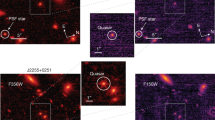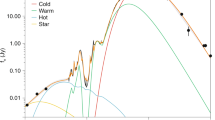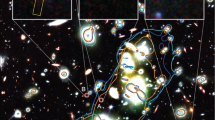Abstract
Two new quasars have recently been found through X-ray observations (the only other one being 3C273, see refs 1, 2). Ricker et al.3 have reported observations confirming the identification of the X-ray source 2251–178 with a quasar of visual magnitude 14.1. Canizares, McClintock, and Ricker4 have reported visual spectrophotometric observations of this quasar, and find its visual spectrum is much like other low redshift quasars. Apparao et al.5 have reported the discovery of a low redshift quasar identified with the X-ray source 4U0241 + 61. Margon and Kwitter6 have reported detailed visual spectrophotometry of this quasar, 0241 + 622, and likewise find that its spectrum is typical of low redshift quasars. Because of the importance of establishing any morphologically unique characteristics of X-ray quasars, these quasars should be observed at all possible wavelengths. We report here IR observations of the two newly discovered X-ray quasars. These observations indicate that the X-ray quasars have IR properties typical of low redshift quasars, and, along with 3C273, are among the brightest known quasars at IR wavelengths.
This is a preview of subscription content, access via your institution
Access options
Subscribe to this journal
Receive 51 print issues and online access
$199.00 per year
only $3.90 per issue
Buy this article
- Purchase on Springer Link
- Instant access to full article PDF
Prices may be subject to local taxes which are calculated during checkout
Similar content being viewed by others
References
Bowyer, C. S., Lampton, M., Mack, J. & de Mendonca, F. Astrophys. J. Lett. 161, L1 (1970).
Kellogg, E. et al. Astrophys. J. Lett. 165, L49 (1971).
Ricker, G. et al. Nature 271, 35 (1978).
Canizares, C. R., McClintock, J. E. & Ricker, G. R. Astrophys. J. Lett. 226, L1 (1978).
Apparao, K. M. V. et al. Nature 273, 450 (1978).
Margon, B. & Kwitter, K. B. Astrophys. J. Lett. 224, L43 (1978).
Neugebauer, G., Oke, J. B., Becklin, E. E. & Matthews, K. Astrophys. J. (in the press).
Johnson, H. L. in Nebulae and Interstellar Matter (eds Middlehurst, B. M. & Aller, L. H.) 193 (University of Chicago Press, 1968).
Code, A. D., Davis, J., Bless, R. C. & Brown, R. H. Astrophys. J. 203, 417 (1976).
Grasdalen, G. Astrophys. J. Lett. 208, L11 (1976).
Puetter, R. C., Smith, H. E., Soifer, B. T., Willner, S. P. & Pipher, J. L. Astrophys. J. Lett. 226, L53 (1978).
Osterbrock, D. E. in Astrophysics of Gsaeous Nebulae, 65 (W. H. Freeman, San Francisco,1974).
Cooke, B. A. et al. Mon. Not. R. astr. Soc. 182, 489 (1978).
Burbidge, G. R., Crowne, A. H. & Smith, H. E. Astrophys. J. Suppl. 33, 113 (1977).
Ward, M. J. et al. Astrophys. J. 223, 788 (1978).
Author information
Authors and Affiliations
Rights and permissions
About this article
Cite this article
SOIFER, B., NEUGEBAUER, G. & MATTHEWS, K. Infrared observations of the X-ray quasars 0241 + 622 and MR2251–178. Nature 278, 231–232 (1979). https://doi.org/10.1038/278231a0
Received:
Accepted:
Issue Date:
DOI: https://doi.org/10.1038/278231a0
Comments
By submitting a comment you agree to abide by our Terms and Community Guidelines. If you find something abusive or that does not comply with our terms or guidelines please flag it as inappropriate.



